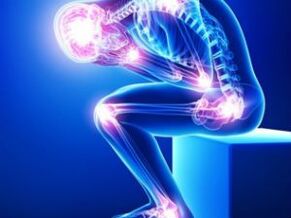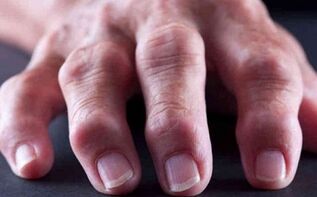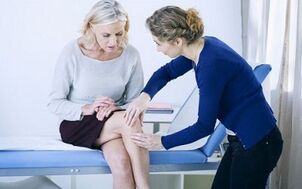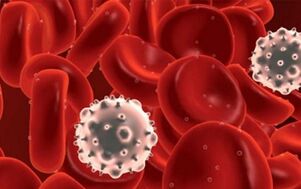
Joint problems often occur locally when a person has pain in a specific joint and can identify the location of the pain. But sometimes joint pain cannot be localized, because all or several joints hurt at the same time. It is premature to speak of rheumatoid arthritis in this case, because, in addition to this pathology, there are other diseases in which pain covers all the joints of the musculoskeletal system.
An attentive physician who will analyze patient complaints and identify cause and effect relationships can identify the reasons why all joints hurt at the same time. Determining the diagnosis is far from always that easy and, with the most common general symptoms, it is not possible to identify a specific pathology immediately, after a series of examinations. Therefore, if systemic joint pain occurs, do not delay visiting the doctor.
If all the joints of the musculoskeletal system are seriously ill, there may be the following reasons:
- Pathologies of autoimmune origin and systemic allergic reactions.
- Rheumatoid arthritis.
- Osteoarthritis.
- Chronic fatigue, increased physical activity.
- Intoxication of the body.
- Diseases of the blood.
When pain appears in several or all joints, one should immediately remember that such a situation is only a reaction to certain diseases, but not to independent diseases. The only exceptions may be pathologies such as osteoarthritis and rheumatoid arthritis, when the immediate cause lies in damage to the cartilage itself.
Rheumatoid arthritis
The disease refers to chronic autoimmune pathologies in which the joints throughout the body are mainly affected. A distinctive feature of rheumatoid arthritis is the involvement of many joints in the pathological process.
At the same time, cytokines, metalloproteinases, and chemotactic cytokines play a key role in the inflammatory process. These are anti-inflammatory elements that activate the activity of the human body's own immune cells. As a result, they move to the site of inflammation, that is, to the joints of the human body, and elicit a typical inflammatory response.
A typical manifestation of rheumatoid arthritis is damage to the peripheral and symmetrical joints. When the disease worsens, the pathology affects the largest joints. The pathology mainly affects women, in men it occurs three times less often. It is diagnosed between the ages of thirty and fifty, but sometimes it can also appear in adolescents; this disease is called juvenile arthritis.
Although scientists have clarified the immune nature of the disease, it has not yet been possible to determine the exact cause of rheumatoid arthritis: why anti-inflammatory cells acquire such pathological activity. To date, a genetic predisposition to rheumatoid arthritis has been proven, it is also indicated that negative factors such as smoking, transmission of viral diseases, etc. , influence the appearance of pathologies.
The course of the disease is due to the activation of immune complexes, which are produced by the synovium and are found in blood vessels. A quick reaction to them are rheumatoid factors, antibodies produced against these complexes. And in some cases, they appear alone, without the presence of provoking factors.
HELP!At an early stage of the development of the pathology, macrophages migrate to the affected areas, after a while the number of lymphocytes increases there. The release of inflammatory mediators and provokes the development of the pathological process throughout the body.
If a chronic lesion of the synovium occurs, instead of its usual thickness, it becomes more dense and thick, grows, and folds in the form of villi form on its surface. Synovial fluid cells produce stromelysin and collagenase, which contribute to destructive processes in cartilage tissue. The inflammatory process is enhanced by the production of prostaglandins, fibrin deposits and necrotic processes appear.
Overgrown synovial tissue causes inflammatory mediators that contribute to the destruction not only of cartilage, but also of bone tissue, ligaments, and joint capsule. In the joint fluid itself, the number of leukocytes increases.
The small joints of the body are covered with the characteristic rheumatoid nodules, when the joint changes shape and becomes ugly in appearance. The content of these rheumatoid nodules is the necrotic part of macrophages, fibroblasts, and plasma cells. Similar nodules can be found in internal organs.
The disease progresses gradually. Patients suffer from general and local joint manifestations: there is a characteristic stiffness in the joints in the morning, fatigue is observed, appetite is lost, the body temperature rises to subfebrile. The condition of the joints improves a lot about an hour after waking up. The joints are affected symmetrically, and rheumatoid arthritis generally affects the following joints:
- Doll.
- Second and third metacarpophalangeal.
- Shoulder.
- Knees.
- Ankles.
- Hip.
- Elbows.
In fact, the disease threatens any joint of the musculoskeletal system. The joints of the distal phalanx, as well as the elements of the axial skeleton, are the least affected.

The joints are still sore, swollen and red, and warm to the touch. To minimize painful sensations, patients try to keep the joints bent, so they hurt less. The progression of the disease occurs in the first 5-6 years after the onset of the first pathological changes. And already ten years after the development of pathology, irreversible changes appear in patients.
During this time, patients develop significant joint deformities and instability may occur. When the nerve branches are compressed, patients suffer from carpal tunnel syndrome, and with rheumatoid arthritis of the knee joint, patients are threatened by Baker's cyst, deep vein thrombosis, etc.
Parallel to joint changes, extra-articular manifestations of the body are observed, which develop with the progression of the pathology in one out of every three patients. An example of such manifestations can be rheumatoid nodules in the lungs, vasculitis, Felty's syndrome, myocarditis.
Diagnosing the disease is not that difficult. The blood shows the typical clinical criteria for rheumatoid arthritis, an increased erythrocyte sedimentation rate, a significant amount of C-reactive protein, and rheumatoid factor.
The health status of patients is specified on an X-ray image, which is performed if rheumatoid arthritis is suspected. The disease differs from osteoarthritis, sarcoidosis, psoriatic arthritis and ankylosing spondylitis, arthritis developed in the context of hepatitis C.
IMPORTANT!When making a diagnosis, it is necessary to take into account that the disease has a fairly high lethal outcome, but in rheumatoid arthritis it is not associated with joint damage, but with pathological changes in the heart, internal bleeding.
Treatment of the disease is carried out with supportive therapy, as well as with powerful NSAIDs. It is recommended to give only an adequate load on the joints, add exercise therapy. If necessary, surgery is performed.
Osteoarthritis
Osteoarthritis is another common condition that can affect both large and small joints. Several factors can lead to osteoarthritis, which, in the first place, have a negative effect on the cartilage tissue of the joint. Cartilage throughout the human body performs various functions and primarily becomes a shock absorber in the process of various movements. Constant stress leads to increased cartilage wear.
If people with good health and strong immunity have the opportunity to restore damaged tissues, in elderly patients, as well as in patients with increased stress on the joint, the synthesis of new fibers almost does not occur and the tissue of thecartilage is not restored. Traditionally, osteoarthritis is considered a consequence of mechanical effects on tissues, but now doctors are considering previously transferred inflammatory diseases as factors in the development of systemic osteoarthritis.
A typical symptom of the disease is pain in all joints, as the matrix loses extremely important substances - glucosamine and chondroitin sulfate. A deficiency of these elements leads to the so-called dislocation of the joint, that is, cracks of various depths appear in the cartilage tissue.
Inflammatory processes can also alter the normal structure of cartilage tissue; therefore, when they are located in the subchondral part of the bone, doctors often diagnose microfractures in patients. The edges of the bone in the joint are covered with growths - osteophytes. They serve to compensate for the worn part of the cartilage, but in fact they provide even more negative sensations to patients.

Menopausal women are the most susceptible to osteoarthritis.
Since the actual cause of osteoarthritis has not been clarified, doctors identify several factors that contribute to the development of the disease:
- Congenital deficiency of cartilage tissue, in which it is very easy to injure oneself. For example, patients with such a pathology develop flat feet, dislocations are often diagnosed, complete and incomplete.
- Gender is also one of the factors in the development of the disease, since according to statistics, osteoarthritis is twice as common in women than in men.
- Age characteristic: the disease usually develops in patients older than forty-five years, in women it coincides with the period of menopause.
- Obesity.
- Metabolic problems.
- Increased sports load on the joints.
- Traumatic joint injuries.
The disease develops in any joint, but generally the initial joint is the one that performs the most physical activity. It can be located in the joints of the knee, hip, elbow, etc.
The symptomatology of the disease is very obvious, so you cannot miss osteoarthritis. In a person, with increased stress, the joints immediately begin to ache, while the strength of the discomfort may be different: from a slight groan in the joint to a sharp and severe pain in the joint. When making movements, the pain increases and at rest it becomes less pronounced.
In parallel with pain, patients suffer from cracks in the joints, the appearance of stiffness. Patients have limited movement. Especially at times of disease progression, when reflex muscle spasms are added to the pathology.
At a later stage in the development of the disease, patients develop a characteristic joint blockage - this is acute pain when the joint suddenly stops moving due to the appearance of severe pain in the joint. This is due to the entry of fragments of cartilaginous tissue into the cavity, blocking movement. If the disease is accompanied by inflammation, then there is swelling of the synovium, which is easy to visualize.
The development of osteoarthritis is quite individual. In some patients, the X-ray shows signs of progression of the pathology, but depending on the sensations, the picture of the disease does not change. At the same time, other patients feel severe pain, inflammation and limited movement, when the joint itself in the picture looks satisfactory, depending on the stage of development of the pathology.
The diagnosis of the disease is based on X-ray data and clinical signs of the disease. In parallel, you can perform an ultrasound or an MRI if it is necessary to evaluate the presence of complications.
Doctors try to treat the disease taking into account the maximum preservation of mobility in the joint and the patient's ability to work by profession. Therefore, in therapy, it is extremely important to stop the progression of the disease, eliminate pain in the joint and relieve inflammation.
At the moment, the possibilities of treating osteoarthritis are not limitless and treatment tactics are difficult to recognize as successful, because it is not possible to restore joints. The disease enters a chronic stage and it is necessary to constantly combat it.
TIP!However, these unhappy prognoses do not condemn patients to disability: With successful therapy, you can learn to live with osteoarthritis and even stay physically active.
For treatment, doctors use the following groups of funds:
- Non-steroidal anti-inflammatory drugs.
- Glucocorticosteroids.
- Chondroprotectors.
- Means to activate blood circulation.
- Muscle relaxants.
The therapy of the disease consists mainly of drugs that can restore the cartilage tissue to the maximum and establish metabolic processes in the joint. Therefore, the main emphasis is on chondroprotectors, the use of which begins immediately after the removal of inflammation. Treatment with chondroprotectors is long-term and the best result appears only with the initiation of timely treatment.
Other diseases
Rheumatoid arthritis and osteoarthritis are the most common pathologies in which the joints ache and ache throughout the body. But, in addition to the leaders in morbidity, there are other conditions that cause joint pain in the joints.

Joint pain can be a manifestation of leukemia.
Sore joints can be a manifestation of blood disorders. Today's hematological pathologies are the most difficult not only in diagnosis for treating physicians, but also in therapy. Often an oncological factor is attached to them and the diseases take on a completely different meaning for the patient. Generally, joints throughout the body ache with leukemia, both acute and chronic. At the same time, patients do not even suspect what this means, since the results of blood tests do not show abnormalities.
Arthralgia is not isolated, not only joint elements are affected, but also bones and muscles. Therefore, doctors advise patients with long-term painful sensations, it is imperative to consult not only a traumatologist or orthopedic surgeon, but also a hematologist who may suspect a pathology and send the patient for further investigation.
Body intoxication is another reason for joint pain. The fact is that the joints react extremely acutely to the intake of toxins in the body, and if they begin to ache and twist the joints, then the influence of occupational hazards, poisoning with household waste, smoking and alcoholismthey may be to blame. Patients suffer extremely unpleasant symptoms: all joints hurt, as if with the flu, the general condition of the body suffers.
It is possible to improve the health status of patients after diagnosis. A detoxification therapy is carried out, the blood and, consequently, the joint fluid is cleansed of toxins.
The most important thing
Pain in all the joints of the body is not always associated with the pathology of the joints themselves. If the body's joints are affected, the cause is usually rheumatoid arthritis or osteoarthritis. The symptoms grow rapidly and the pathological process in the joints progresses.
In other cases, when joint pain is not associated with joint damage, the discomfort may be a manifestation of systemic diseases, for example, blood leukemia, as well as osteoporosis, bodily intoxication and infection. Coping with illness is not that easy, but it is much more difficult to diagnose illness. Patients with the appearance of joint pain should contact the clinic in a timely manner to start treatment at an early stage.

























